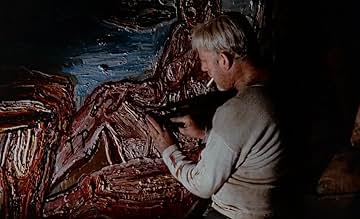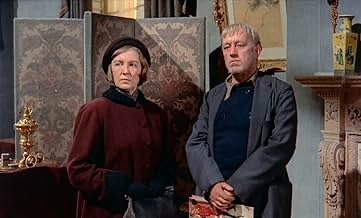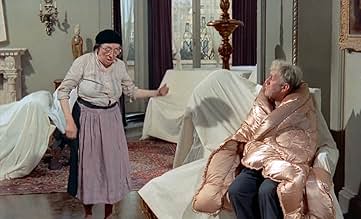VALUTAZIONE IMDb
6,9/10
4070
LA TUA VALUTAZIONE
Aggiungi una trama nella tua linguaAn ill-behaved, lovably scruffy painter, Gulley Jimson, searches for a perfect canvas, determined to let nothing come between himself and the realization of his exalted vision.An ill-behaved, lovably scruffy painter, Gulley Jimson, searches for a perfect canvas, determined to let nothing come between himself and the realization of his exalted vision.An ill-behaved, lovably scruffy painter, Gulley Jimson, searches for a perfect canvas, determined to let nothing come between himself and the realization of his exalted vision.
- Candidato a 1 Oscar
- 5 vittorie e 6 candidature totali
Renee Houston
- Sara Monday
- (as Renée Houston)
John Adams
- Police Officer
- (non citato nei titoli originali)
Chris Adcock
- Workman
- (non citato nei titoli originali)
Andy Alston
- Workman
- (non citato nei titoli originali)
Timothy Bateson
- Clerk to Borough Surveyor
- (non citato nei titoli originali)
Victor Brooks
- Foreman
- (non citato nei titoli originali)
Peter Bull
- Man in Taxi
- (non citato nei titoli originali)
Recensioni in evidenza
My late wife, an artist, loved this film, and it gave me such insights into the way her mind worked. Guiness is wonderful; for once we see many levels of the character he portrays. Kay Walsh is so touching as the woman in his life, while Mike Morgan makes the perfect art groupie. It's funny to see Dr. Pastorious in old age; he has barely changed since Bride of Frankenstein.
The humor is gentle and quiet except for the studio renovation scene, but it is when Gully stands in front of a canvas that the truth of this film comes out. His almost soliloquy on the human foot; the scene where he shrugs and says that was not what he was trying to say, after he has ruined the toff's wall, these are priceless and our entry into an artist's mind. When the houseboat sets sail down the Thames, to the comment about the sea by the looney who pipes Gully aboard is a bit of perfection set on celluloid. He stands there, framing a vision of another canvas on the hull of a freighter, while reciting this wonderful doggerel that I always get mixed up when I try to say it, and all the while Nosey and Sara spur him on. I've never read the book and wonder if this represents his death, but I take from it what I will.
One other thought: there are certain films shot on location that should be filed away as time/place documentaries. This one is a perfect example: London 1958.
The humor is gentle and quiet except for the studio renovation scene, but it is when Gully stands in front of a canvas that the truth of this film comes out. His almost soliloquy on the human foot; the scene where he shrugs and says that was not what he was trying to say, after he has ruined the toff's wall, these are priceless and our entry into an artist's mind. When the houseboat sets sail down the Thames, to the comment about the sea by the looney who pipes Gully aboard is a bit of perfection set on celluloid. He stands there, framing a vision of another canvas on the hull of a freighter, while reciting this wonderful doggerel that I always get mixed up when I try to say it, and all the while Nosey and Sara spur him on. I've never read the book and wonder if this represents his death, but I take from it what I will.
One other thought: there are certain films shot on location that should be filed away as time/place documentaries. This one is a perfect example: London 1958.
One of the best movies about art ever made, `The Horse's Mouth' examines the relationships between vision and creation, between art and commerce, and most importantly between art and criticism; and makes us laugh at the same time. Alec Guinness is inspired (when was he ever not inspired, come to think of it) as Gully Jimson, a painter of unlimited ideas who has met with only limited success in the art marketplace partly because he is so contemptuous of that marketplace. His search for the perfect wall on which to paint, and the subject matter he ultimately winds up painting on one of the walls found in his search, is priceless. The Joyce Cary novel, and its companions in the Jimson trilogy (`Herself Surprised' and `To Be a Pilgrim') are well worth reading, but this movie is a very British, very engaging classic. In many ways, it's the movie that `Pollack' (good though it was) should have been.
Alec Guinness not only stars in what amounts to a one-man show as aging, struggling London painter Gulley Jimson, he also wrote the script. Funny he got an Oscar nomination for the writing, and not for the acting.
As Jimson, Guinness is a memorably growly, seedy type, testament to the artistic impulse of man running afoul of polite society. Even his nasty Fagin from "Oliver Twist" was affable company; Jimson tells off his young admirer Nosey (Mike Morgan) with a convincingly hoarse "Go do something sensible, like shooting yourself." It's all for laughs, of course, except when "The Horse's Mouth" gets mildly serious, mostly when Jimson holds forth on his vision of art.
"Half a minute of revelation's worth a million years of know-nothing," he tells his companion Coker (Kay Walsh).
"Who lives a million years?" is her sharp reply.
"A million people every 12 months."
"A Horse's Mouth" isn't always so smart. Walsh plays her part too shrill, Morgan his too moony, and the artist who provided Jimson's paintings, John Bratby, uses too much red. After establishing Jimson, Guinness's script doesn't do much with him. He paints some walls, gets into some trouble, and sails away, leaving others to bear witness to his "genius".
What I like most about this film, other than Guinness's fine acting and occasional scenes here and there that feature his character to good effect, is the vivid picture you get of London circa the late 1950s, double-decker buses with hoardings for Gordon's Gin and Ty-Phoo Tea on their sides. Also, director Ronald Neame finds interesting angles to frame the film from in order to give the on-screen action (rarely painting itself, but frequently static conversation shots) a bit of vitality, and often outside with lively streetscape backdrops.
This is like a David Lean movie once removed. Neame was Lean's cinematographer in his early days, Guinness was Lean's favorite actor, and Walsh was Lean's ex-wife. Even Anne V. Coates, later the Oscar-winning editor of "Lawrence Of Arabia", snipped this as well.
She deserved her Oscar; not so Guinness his nomination here. As a comedy, "The Horse's Mouth" is a bit of a miss. A scene of Jimson ruining a rich couple's penthouse apartment is painfully unfunny, especially when a sculptor friend of Jimson (Michael Gough) arrives out of nowhere to add to the mess. Most of the other business in the movie, like a struggle between Jimson and his ex-wife for a portrait of her he needs for painting money, feels like chopped-down scenes from Cary's novel mined for easy laughs, at some expense to story.
I didn't care much about Jimson by story's end, but I did enjoy his company, or rather that of Guinness playing Jimson, staring at a charwoman and fixated by her feet, "...old women's feet...thin, flat, long...clinging to the ground like reptiles". Like much else in regard to the movie, I'm at a loss to what it means, but I value the experience. That counts for something with art.
As Jimson, Guinness is a memorably growly, seedy type, testament to the artistic impulse of man running afoul of polite society. Even his nasty Fagin from "Oliver Twist" was affable company; Jimson tells off his young admirer Nosey (Mike Morgan) with a convincingly hoarse "Go do something sensible, like shooting yourself." It's all for laughs, of course, except when "The Horse's Mouth" gets mildly serious, mostly when Jimson holds forth on his vision of art.
"Half a minute of revelation's worth a million years of know-nothing," he tells his companion Coker (Kay Walsh).
"Who lives a million years?" is her sharp reply.
"A million people every 12 months."
"A Horse's Mouth" isn't always so smart. Walsh plays her part too shrill, Morgan his too moony, and the artist who provided Jimson's paintings, John Bratby, uses too much red. After establishing Jimson, Guinness's script doesn't do much with him. He paints some walls, gets into some trouble, and sails away, leaving others to bear witness to his "genius".
What I like most about this film, other than Guinness's fine acting and occasional scenes here and there that feature his character to good effect, is the vivid picture you get of London circa the late 1950s, double-decker buses with hoardings for Gordon's Gin and Ty-Phoo Tea on their sides. Also, director Ronald Neame finds interesting angles to frame the film from in order to give the on-screen action (rarely painting itself, but frequently static conversation shots) a bit of vitality, and often outside with lively streetscape backdrops.
This is like a David Lean movie once removed. Neame was Lean's cinematographer in his early days, Guinness was Lean's favorite actor, and Walsh was Lean's ex-wife. Even Anne V. Coates, later the Oscar-winning editor of "Lawrence Of Arabia", snipped this as well.
She deserved her Oscar; not so Guinness his nomination here. As a comedy, "The Horse's Mouth" is a bit of a miss. A scene of Jimson ruining a rich couple's penthouse apartment is painfully unfunny, especially when a sculptor friend of Jimson (Michael Gough) arrives out of nowhere to add to the mess. Most of the other business in the movie, like a struggle between Jimson and his ex-wife for a portrait of her he needs for painting money, feels like chopped-down scenes from Cary's novel mined for easy laughs, at some expense to story.
I didn't care much about Jimson by story's end, but I did enjoy his company, or rather that of Guinness playing Jimson, staring at a charwoman and fixated by her feet, "...old women's feet...thin, flat, long...clinging to the ground like reptiles". Like much else in regard to the movie, I'm at a loss to what it means, but I value the experience. That counts for something with art.
Although most Americans have little knowledge of his work other than Star Wars, Alec Guinness produced an amazing body of work--particularly in the 1940s-1950s--ranging from dramas to quirky comedies. I particularly love his comedies, as they are so well-done and seem so natural and real on the screen--far different from the usual fare from Hollywood.
I first saw this movie when I was about 13 or so, and didn't appreciate it very much. Years later, when I became fascinated with Guinness' comedies, I decided to give it another chance. And boy am I glad I did!! The movie concerns the life of an extremely edgy and rather nasty artist. Guinness really plays this up and creates one of the quirkiest and funniest characters I have ever seen. In essence, the man is a rascal that is driven to create his art regardless of what it takes to get it done! What I missed the first time I saw the film were the extremely catchy music and the amazing art created for this movie. I am not the biggest fan of modern art, but the second time i saw the movie I really liked most of the works done for the movie--it just was a darn shame that much of it was destroyed in the course of the movie! In addition to music and art, the performances throughout of all the actors was nearly perfect.
Finally, the version of the movie I saw last was from the Criterion Collection. Get this version!!!! It had so much wonderful background information about the actual art, the making of the movie, and interesting background information--such as how they got the musical score WITHOUT having to pay royalties and the incredibly sad tale of a magnificent performance by a young supporting actor that did not live to see the finished product.
I first saw this movie when I was about 13 or so, and didn't appreciate it very much. Years later, when I became fascinated with Guinness' comedies, I decided to give it another chance. And boy am I glad I did!! The movie concerns the life of an extremely edgy and rather nasty artist. Guinness really plays this up and creates one of the quirkiest and funniest characters I have ever seen. In essence, the man is a rascal that is driven to create his art regardless of what it takes to get it done! What I missed the first time I saw the film were the extremely catchy music and the amazing art created for this movie. I am not the biggest fan of modern art, but the second time i saw the movie I really liked most of the works done for the movie--it just was a darn shame that much of it was destroyed in the course of the movie! In addition to music and art, the performances throughout of all the actors was nearly perfect.
Finally, the version of the movie I saw last was from the Criterion Collection. Get this version!!!! It had so much wonderful background information about the actual art, the making of the movie, and interesting background information--such as how they got the musical score WITHOUT having to pay royalties and the incredibly sad tale of a magnificent performance by a young supporting actor that did not live to see the finished product.
This is probably my favorite movie. It may be overstatement to call a mere British comedy a timeless classic, but this outstanding movie, beneath its raucously madcap surface, has some very serious things to say about what it means to be an artist, to be driven by visions while living in a society that doesn't care. I think Guinness is the greatest actor of the century, and that his performance here as the maddening, irascible, impossible Gulley Jimson is the zenith of his movie roles. Kay Walsh, who partnered with Sir Alec in Tunes of Glory, is equally brilliant.
Having said that, I recently read Joyce Cary's novel, on which the movie is based, and I have to say that the book is much darker than the movie, which plays up the darkly comic scenes of the novel while diminishing - or even omitting - some of the darker moments. Still, the movie stands well on its own, even if it is a somewhat different entity than the book.
Having said that, I recently read Joyce Cary's novel, on which the movie is based, and I have to say that the book is much darker than the movie, which plays up the darkly comic scenes of the novel while diminishing - or even omitting - some of the darker moments. Still, the movie stands well on its own, even if it is a somewhat different entity than the book.
Lo sapevi?
- QuizWhen Nosey offers Bisson a bowl of stew, Michael Gough's voice on the soundtrack says "Buzz off!" but his lips form the words "Drop dead!" Presumably the line was changed when Mike Morgan died suddenly before the movie was released.
- BlooperWhen Nosey tries to feed Lolley while she's posing nude for Abel's sculpture, it's briefly revealed that the actress is in fact wearing a top.
- Citazioni
Gulley Jimson: Go and do something sensible, like shooting yourself! But don't be an artist!
- Colonne sonoreLieutenant Kijé Op. 60
Written by Sergei Prokofiev (as Prokofieff)
Arranged by Kenneth V. Jones
Conducted by Muir Mathieson
I più visti
Accedi per valutare e creare un elenco di titoli salvati per ottenere consigli personalizzati
- How long is The Horse's Mouth?Powered by Alexa
Dettagli
- Data di uscita
- Paese di origine
- Sito ufficiale
- Lingue
- Celebre anche come
- The Horse's Mouth
- Luoghi delle riprese
- Wormwood Scrubs Prison, Du Cane Road, East Acton, Londra, Inghilterra, Regno Unito(exteriors Gulley Jimson leaving prison)
- Azienda produttrice
- Vedi altri crediti dell’azienda su IMDbPro
- Tempo di esecuzione1 ora 37 minuti
- Colore
- Proporzioni
- 1.66 : 1
Contribuisci a questa pagina
Suggerisci una modifica o aggiungi i contenuti mancanti

Divario superiore
By what name was La bocca della verità (1958) officially released in India in English?
Rispondi





























